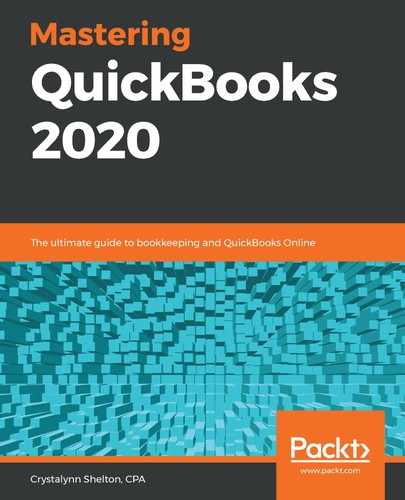Setting up payroll in QuickBooks Online can be done in seven easy steps. First, you will navigate to the Workers tab and select the Get Started button. Next, you will select the payroll plan you wish to subscribe to. After selecting a plan, you will enter basic information for each employee, including their name, email, and hire date. The next step requires you to select a payment schedule and enter the employee's pay rate, deductions, and withholdings from their W-4 form. If the employee chooses direct deposit, you will need to have them complete a direct deposit authorization form. Repeat these steps for each employee and setup will be complete.
Follow the steps to set up payroll in QBO:
- Click on Workers on the left menu bar to navigate to the Employee Center, as shown in the following screenshot:

- Activate the payroll by clicking on the Get started button, as indicated in the following screenshot:

- In the next screen, you will have the option of selecting a payroll plan, as indicated in the following screenshot:

The following is a brief explanation of each QuickBooks Online payroll plan:
- QuickBooks Self Service Payroll Plan: This plan is ideal for employers who prefer to manage their payroll in-house. The subscription fee includes updated payroll tax tables that are used to automatically calculate payroll taxes and payroll checks for you—no manual calculation required! With this plan, you can process payroll checks, electronically make payroll tax payments, and file payroll tax forms.
- QuickBooks Full Service Payroll Plan: This plan is ideal for employers that prefer to outsource their payroll duties. The subscription fee includes payroll setup, processing payroll checks and direct deposit payments, completing payroll tax forms, and making payroll tax payments. Also, Intuit will process all year-end tax forms and filings such as mailing and filing W-2 forms.
- After selecting a plan, the payroll dashboard should display on your screen, as indicated in the following screenshot:

- After clicking the Get started button (shown in the preceding screenshot), the following screen will display:

To add a new employee, enter their first and last name, hire date, and email address. Check the box under the email address to invite the employee to an online portal where they can view and print their pay stubs and W-2 forms.
- Complete employee payroll information, as indicated in the following screenshot:

A brief explanation of the employee information required follows:
- Create a pay schedule: Create a pay schedule based on when you pay employees. You can create one pay schedule for all employees (for example, every other Friday) or multiple pay schedules—one for hourly employees and one for salary employees. Click on the Create pay schedule link in step 2 (shown in the preceding screenshot) to get started.
- Employee pay rate: In step 3, set up the hourly rate or annual salary for an employee. You can also set up other payment types such as overtime, sick leave, and vacation. Click on the Add additional pay types link and follow the on-screen prompts.
- Employee deductions: Add all applicable employee deductions in step 4. This includes health benefits, 401K contributions, and wage garnishments. Click the Add deductions link to get started.
- Employee withholdings: Enter the employee withholding information from the W-4 form completed by the employee. This information will determine the amount of federal and state income taxes that will be deducted from the employee's payroll check.
- Payment method: From the drop-down box, select check or direct deposit as the payment method. If an employee elects a direct deposit, use the completed direct deposit authorization form discussed previously to complete the routing number and account number of the financial institution.
- After entering the employee information, your screen should resemble the following screenshot:

In this section, we have shown you how to add employees and their tax deductions, tax withholdings, and payment methods. Be sure to complete steps 1 through 7 for all employees. Once you have set up all of your employees, you are ready to run payroll. The number of payroll schedules created in step 6 will determine how often you run payroll. If all employees get paid on the same day, you will run the payroll based on the number of times employees are paid (for example, weekly or bi-weekly). In the next section, we will show you how to run your payroll in five easy steps.
